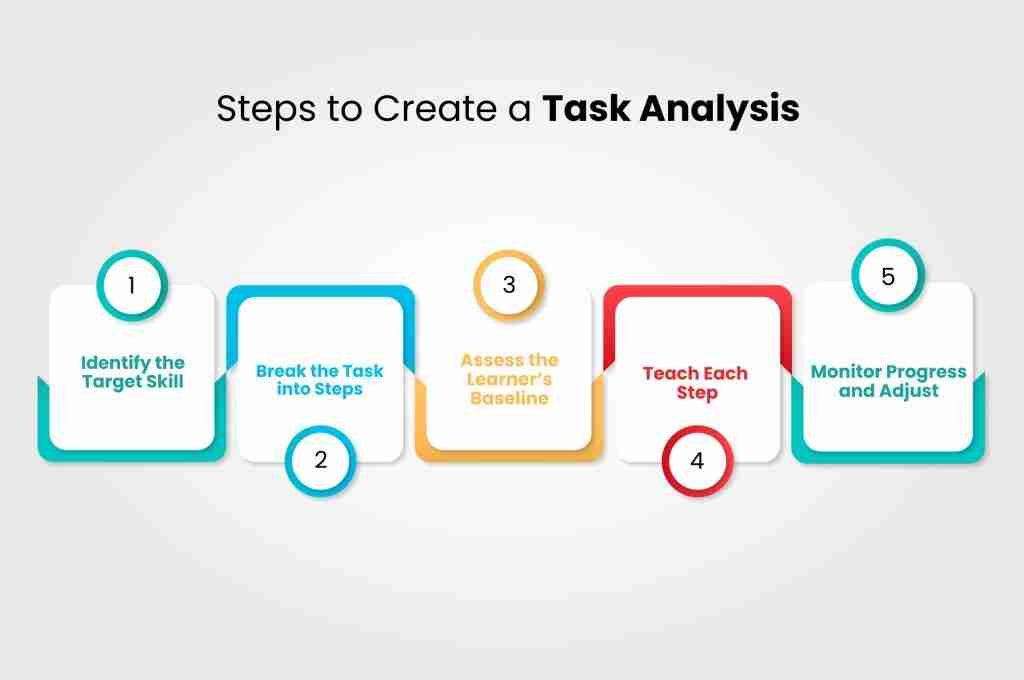Task Analysis in ABA: A Comprehensive Guide to Empowering Learning
ABA TherapyJuly 17, 2025

Introduction to Task Analysis
Task analysis is a fundamental technique in Applied Behavior Analysis (ABA) therapy that involves breaking down complex skills or behaviors into smaller, manageable steps.
This method is particularly significant for individuals with autism, developmental delays, or learning disabilities who may find multi-step tasks overwhelming. By simplifying these tasks, we can create a clearer pathway to learning and independence.
Table of Contents
What is Task Analysis?
In the context of ABA therapy, task analysis serves as a blueprint for teaching. It allows therapists and educators to dissect a skill into its constituent parts, making it easier for learners to understand and master each component.
For example, when teaching a child how to make a sandwich, task analysis would involve outlining each step—from gathering ingredients to spreading the peanut butter—thus transforming an intimidating task into a series of achievable actions.
Why Task Analysis is Important
Task analysis plays a crucial role in fostering independence among individuals with special needs. Here are some key reasons why it is essential:
- Facilitates Skill Acquisition: By breaking down tasks, learners can focus on mastering one step at a time, which can lead to improved skill acquisition and retention.
- Enhances Confidence: As individuals successfully complete each step, their confidence grows, encouraging them to tackle more complex tasks.
- Promotes Generalization: Skills learned through task analysis can often be generalized across different settings, enabling individuals to perform tasks independently in various environments.
Types of Task Analysis
There are several methods of task analysis that can be employed depending on the learner's needs:
Forward Chaining
In forward chaining, instruction begins with the first step of the task. Once the learner masters this initial step, subsequent steps are introduced one at a time. This method allows learners to experience success early on.
Backward Chaining
Backward chaining starts with the final step of the task. The learner completes this last step independently while the earlier steps are taught and reinforced. This approach can boost motivation as learners see immediate results from their efforts.
Total Task Presentation
This method involves teaching all steps of the task simultaneously while providing support as needed. Total task presentation is beneficial for learners who may need assistance throughout the entire process but can still engage with each step.
Steps to Create a Task Analysis
Creating an effective task analysis involves several systematic steps:

- Identify the Target Skill: Choose a specific skill or behavior that needs instruction (e.g., brushing teeth).
- Break the Task into Steps: List all necessary steps required to complete the task. Ensure each step is clear and manageable.
- Assess the Learner’s Baseline: Determine which steps the individual can already perform independently and where they require support.
- Teach Each Step: Use chaining techniques to instruct each step in order while providing prompts and reinforcement as necessary.
- Monitor Progress and Adjust: Continuously track progress and modify steps or levels of support based on the learner's performance.
Examples of Task Analysis in Action
Task analysis can be applied across various domains:
Daily Living Skills
For instance, teaching daily living skills such as getting dressed can be broken down into steps like selecting clothes, putting on socks, buttoning shirts, etc.
Communication Skills
Task analysis can also enhance communication abilities by teaching conversational skills—like taking turns speaking or maintaining eye contact—through structured steps.
Academic Skills
Academic tasks such as solving math problems or writing paragraphs can be deconstructed using task analysis for more effective learning experiences.
Task Analysis in ABA Therapy
ABA therapists utilize task analysis extensively to teach essential life skills. The integration of positive reinforcement and prompting strategies—such as verbal or gestural prompts—during each step is critical for effective learning outcomes.
Data collection plays a vital role in this process; it helps therapists monitor progress and ensure that skill acquisition is on track. By analyzing data, therapists can make informed decisions about adjusting teaching methods or supports as needed.
Challenges in Task Analysis
While task analysis is an effective teaching strategy, it does come with challenges:
- Determining Step Complexity: It can be difficult to decide how many steps are appropriate for a given task without overwhelming the learner.
- Selecting Appropriate Prompts: Choosing the right level of prompts may require trial and error to find what works best for each individual.
Solutions to Overcome Challenges
To address these challenges:
- Consult with other professionals or colleagues for insights on effective strategies.
- Break tasks into even smaller steps if learners struggle with larger segments.
- Modify tasks based on ongoing assessments of the learner's abilities and progress.
Tips for Parents and Caregivers
Parents play an essential role in implementing task analysis at home. Here are some practical tips:

- Incorporate into Daily Routines: Use everyday activities—like making a bed or cleaning up toys—as opportunities for task analysis.
- Be Patient and Supportive: Encourage your child by celebrating small successes along the way.
- Utilize Resources: Explore books, online courses, or workshops focused on ABA techniques to enhance your understanding of task analysis.
Conclusion
Task analysis is a powerful tool that enables individuals with autism and developmental delays to learn complex skills systematically. By breaking down tasks into smaller components, we empower learners to achieve independence while building confidence along their journey.
At Illuminate ABA, we understand the importance of personalized approaches in therapy. If you're interested in creating tailored task analysis programs for your child or loved one, we invite you to consult with our dedicated team today. Together, we can foster growth and independence through effective learning strategies!
Learn More: Discover Pairing in ABA Therapy
